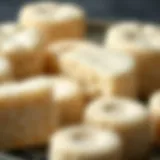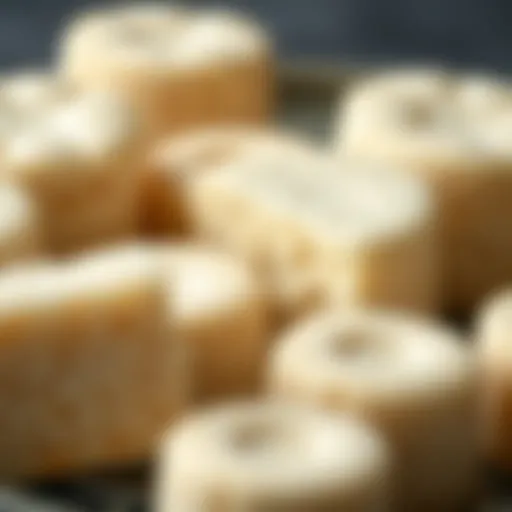The Intricacies of Glass Chopsticks: An In-Depth Exploration
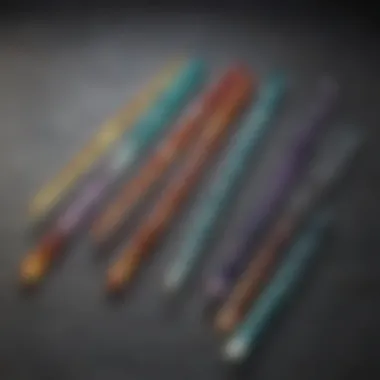

Intro
Glass chopsticks are emerging as a sophisticated alternative to traditional wooden or plastic utensils. They bridge aesthetics with functionality, merging culture and culinary practices. As we explore glass chopsticks, it is crucial to understand their craftsmanship, material implications, and their role in modern dining.
Historically, chopsticks have been integral to various cuisines in Asia. The material choice has evolved over time. With the rise of glass as an option, we find a unique marriage of art and utility. Beyond their elegant appearance, glass chopsticks offer benefits like easy cleaning and a distinctive feel while eating.
Through this exploration, we will delve into the various dimensions of glass chopsticks, examining the choices in design and the cultural context. We will analyze how they enhance the dining experience, providing insights that appeal to culinary enthusiasts and casual diners alike.
Foreword to Glass Chopsticks
Chopsticks are more than mere utensils; they encapsulate cultural traditions and culinary artistry. Understanding glass chopsticks brings forth a nuanced perspective. Their significance spans from being practical tools to symbols of modern dining elegance. This section lays the groundwork for appreciating the multifaceted roles glass chopsticks play in contemporary society.
Definition and Overview
Glass chopsticks are utensils crafted from glass, primarily used in East Asian cuisine. Unlike traditional wooden or metal chopsticks, glass variants offer unique aesthetic and functional characteristics. They are often designed with an emphasis on style, making them suitable for elegant dining experiences. Their transparent nature allows the dish to remain the focal point, highlighting its visual appeal. Furthermore, glass chopsticks can be made from different types of glass, each with distinctive qualities.
Historical Context of Chopsticks
The history of chopsticks dates back thousands of years, with origins traced to ancient China. Initially used for cooking and serving food, they evolved into dining utensils by the Han Dynasty (206 BC – 220 AD). This transition marked the beginning of chopsticks' widespread usage across Asia. Japan, Korea, and Vietnam adopted the practice, each customizing the design and usage based on cultural preferences. The adaptation of chopsticks through history reflects not only changes in culinary practices but also the societal values surrounding food and dining rituals.
In contemporary settings, glass chopsticks continue this legacy. Their modernity may appeal to younger generations while still honoring traditional customs. The innovation in design and materials enhances their role as a bridge between historical practices and contemporary dining aesthetics.
Understanding glass chopsticks is key to appreciating both their practicality and their cultural significance.
Material Composition of Glass Chopsticks
The topic of material composition in glass chopsticks is critical to understanding their functionality, aesthetic appeal, and overall impact on dining experiences. Many factors contribute to this significance, including durability, weight, and how these chopsticks interact with various types of cuisine. Because different types of glass can possess distinct characteristics, knowing these differences helps consumers make informed choices regarding their use and care.
Types of Glass Used
Various types of glass are utilized in the production of chopsticks. Most commonly, there are borosilicate glass and soda-lime glass.
- Borosilicate Glass: This glass is known for its heat resistance and low thermal expansion. It makes the chopsticks less likely to shatter under rapid temperature changes, making it suitable for both cooking and serving purposes.
- Soda-Lime Glass: This type is cheaper and more common, but it can be less durable. It is easier to mold into various designs but may not withstand harsh usage as effectively as borosilicate glass.
In addition, there are more specialized glasses that incorporate various minerals and colorants. These additives enhance not only the appearance but can also serve functional roles, like improving grip and making the utensils visually appealing on a dining table.
Sustainability and Environmental Impact
The sustainability of glass chopsticks hinges primarily on their production processes and life cycle. Glass is inherently a sustainable material in the sense that it is recyclable. Unlike single-use plastic utensils, glass chopsticks can be reused multiple times without degrading in quality.
However, the production of glass can be resource-intensive, requiring significant amounts of energy. It involves melting raw materials at high temperatures, which leads to carbon emissions. Consumers should consider the source of the glass and the ethical practices of manufacturers in production.
In many regions, there are initiatives aiming to promote environmentally friendly practices in glass production. These include:
- Increasing the use of recycled glass in new products
- Utilizing renewable energy sources in the manufacturing process
- Reducing waste and emissions throughout the production cycle
Ultimately, while the benefits of glass chopsticks include longevity and recyclability, it is essential for consumers to seek out brands committed to sustainable practices.
"Choosing glass chopsticks is not just a matter of preference but also an alignment with sustainable dining practices."
Understanding these facets of material composition helps elevate the discussion around glass chopsticks from mere utensils to significant players in contemporary dining culture.
Design Features of Glass Chopsticks
The design of glass chopsticks is not merely about aesthetics; it also encompasses functionality and cultural resonance. Understanding these design features is essential for appreciating how they enhance the dining experience. Key elements such as aesthetics and function contribute to their growing popularity in modern culinary settings.
Aesthetic Elements
The visual appeal of glass chopsticks is undeniable. Their transparency and often intricate designs make them a striking addition to any table setting. Many artisans incorporate colors and patterns, transforming a simple utensil into a work of art.
Some factors that enhance the aesthetic value include:
- Unique Designs: Different shapes and engravings reflect cultural motifs or personal artistic flair. These details resonate with users and create a conversation piece during meals.
- Color Variations: A variety of color options allow consumers to select chopsticks that match their preferences or the theme of their dining experience.
- Finish Appeal: The smooth, polished surface of glass ensures that these chopsticks not only look elegant but also feel pleasant to hold.
This emphasis on aesthetics elevates the experience of using glass chopsticks, making dining more immersive and culturally enriched.
The visual impact of glass chopsticks can turn a standard meal into an aesthetically pleasing occasion.
Functional Aspects
Functionality is equally vital when discussing design features. Glass chopsticks are not just attractive; they are designed for usability and performance in various culinary contexts. Several practical features enhance their function, including:
- Weight and Balance: Most glass chopsticks are crafted to ensure the right weight, allowing for comfortable grip and effective maneuvering of foods.
- Hygienic Properties: Glass does not retain odors or flavors, making it a hygienic choice for diners. It is easy to clean and can be sanitized without concern for material degradation.
- Heat Resistance: Many glass chopsticks are designed to withstand heat, allowing them to be safely used in cooking tasks, such as stirring hot dishes without risk of melting or warping.
- Custom Lengths: Many manufacturers offer various lengths to accommodate different user preferences, from standard to extended lengths, ensuring versatility for various uses.
In summary, the design features of glass chopsticks merge visual allure with practical function, meeting both aesthetic desires and practical needs in the dining experience.
Cultural Significance of Chopsticks
Chopsticks are not merely utensils; they are deeply embedded in the cultural fabric of societies, particularly in Asia. Throughout history, they have evolved in their design and usage, representing more than just a means to eat. In this section, we explore the intricacies of how chopsticks manifest cultural values, traditions, and social practices. Their significance extends to various rituals and conventions, influencing everyday dining philosophies in Asian cultures.
Chopsticks in Asian Cultures
In many Asian countries, chopsticks symbolize more than practicality. They are instruments of etiquette and tradition. Countries such as China, Japan, Korea, and Vietnam have distinct chopstick usage rules that reflect their cultural attitudes toward dining and respect. For instance, in China, it is considered disrespectful to stick chopsticks vertically into a rice bowl, as this resembles the funeral rites. Similarly, in Japan, chopstick etiquette includes not passing food from one pair of chopsticks to another, to avoid evoking the same reaction.
The materials and designs of chopsticks also vary across regions. Chinese chopsticks tend to be longer and may be made of wood or bamboo, reflecting their ancient history. Japanese chopsticks, often lacquered and shorter, may display intricate designs, indicating a focus on aesthetics. In Korea, metal chopsticks are predominant, embodying the traditions of durability and hygiene.


The choice of chopstick material holds cultural significance; each type tells a story of its origin and practical use in that specific society.
These distinctions highlight a relationship between functionality and cultural identity. As such, chopsticks are often viewed as an extension of heritage and community, bringing families together over shared meals.
Evolving Trends and Global Adoption
As global dining trends evolve, so do chopsticks. They have started crossing cultural boundaries, becoming popular in various culinary scenes beyond Asia. With the surge of Asian cuisines worldwide, the use of chopsticks has garnered attention among non-Asian food enthusiasts. This phenomenon can be attributed to various factors:
- Fusion Cuisines: Many restaurants offer a mix of traditional Asian dishes with regional flavors, encouraging the use of chopsticks to enhance the dining experience.
- Cultural Exchanges: Increased travel and cultural exchanges expose people to diverse eating practices, leading to a wider acceptance of chopsticks as versatile dining tools.
- Sustainability Awareness: As consumers lean towards eco-friendly dining solutions, glass and reusable chopsticks reflect a shift toward sustainability, giving rise to their popularity across a broader audience.
The adoption of chopsticks in Western dining spaces often involves a learning curve as well. Some people initially face difficulty using chopsticks, leading to the development of beginner-friendly chopstick designs. Manufacturers have created training chopsticks that are easier to use, such as those with built-in grips or connected bases.
The journey of chopsticks from traditional tools to contemporary dining experiences illustrates their adaptability. Their cultural significance remains relevant, bridging gaps between varied dining customs and promoting an appreciation of the culinary arts.
Culinary Applications of Glass Chopsticks
Exploring culinary applications of glass chopsticks reveals their importance not only as utensils but also as an essential component in various food preparation and consumption methods. Glass chopsticks serve multiple purposes in both cooking and dining settings. They are increasingly recognized for their unique qualities, such as heat resistance and aesthetic appeal. Understanding how these chopsticks are integrated into culinary practices enhances the overall dining experience.
Cooking Techniques with Glass Chopsticks
Using glass chopsticks in cooking requires some adjustments compared to traditional wooden or plastic varieties. Their sturdiness allows for a range of cooking techniques. Here are some notable methods:
- Stir-frying: Glass chopsticks can be effectively used for stir-frying as they withstand high temperatures without bending. This method is popular in Asian cuisine for preparing vegetables, meats, and seafood quickly.
- Tossing Salads: These chopsticks make tossing components in salads easier, as they do not absorb flavors or scents from food, maintaining the dish's integrity.
- Picking and Plating: They can be used for precise picking and plating of delicate items like sushi or garnishes, providing both control and style.
While using glass chopsticks, there are some precautions to consider. Unlike more traditional materials, the smooth surface of glass can be slippery. Thus, a firm grip is necessary to avoid dropping food. Additionally, care must be taken with the temperature as the glass can get quite hot during cooking.
Pairing Glass Chopsticks with Cuisine Types
Different cuisines can benefit from the unique characteristics of glass chopsticks. Here are some examples of suitable cuisine pairings:
- Japanese Cuisine: Glass chopsticks blend seamlessly with the presentation of sushi and sashimi. Their transparent nature enhances the visual appeal of these dishes, making them more appetizing.
- Chinese Cuisine: When used for dishes like noodles or stir-fried vegetables, they provide not only functionality but also a modern twist to traditional meals.
- Thai Cuisine: The heat-resistant properties work well for curries and hot dishes where precise handling is important. The chopsticks allow for easy maneuvering in dishes with complex textures.
- Fusion Dishes: In contemporary dining, where cuisines mingle, glass chopsticks offer versatility. They can bridge the gap between various culinary traditions, demonstrating the evolution of dining experiences.
Overall, the applications of glass chopsticks in cooking and pairing with different cuisines reveal their multifaceted nature. They encourage innovation while respecting tradition, serving as a connecting thread between various culinary practices.
"Glass chopsticks not only enhance the aesthetic of dining but they also serve practical cooking purposes, emphasizing their growing relevance in modern gastronomy."
With this understanding of culinary applications, diners and chefs alike can appreciate the role glass chopsticks play in enhancing both food preparation and consumption.
Health and Safety Considerations
The relevance of health and safety in using glass chopsticks cannot be overstated. Given their distinct material properties, glass chopsticks offer advantages in hygiene and strength when compared to traditional wooden or plastic versions. This section will address these aspects in detail, focusing on the hygienic benefits and potential concerns regarding durability and breakage.
Hygienic Properties of Glass
Glass is inherently non-porous, providing an excellent surface for food contact. Unlike wood or plastic, it does not absorb oils, stains, or odors. This feature is particularly beneficial for maintaining a clean dining experience.
- Easy to Clean: Glass chopsticks can be thoroughly cleaned in hot water without the worry of damage. They can also be placed in a dishwasher, making them user-friendly.
- Chemical Resistance: Glass is resistant to many chemicals. This makes it safe to use with various sauces and foods that might degrade other materials.
"The non-porous nature of glass makes it one of the most hygienic materials for dining utensils."
- Allergenic Potential: People with sensitivities or allergies to certain woodworking finishes or plastics can confidently use glass chopsticks.
For these reasons, glass chopsticks stand out as a viable option for health-conscious individuals.
Durability and Breakage Concerns
While glass chopsticks offer numerous benefits, their durability is a common concern for many users. Here, safety considerations are paramount.
- Material Strength: High-quality glass chopsticks are designed to withstand typical use in dining settings. Brands like Duralex proude glass chopsticks which are known for their strength.
- Potential for Breakage: Despite their strength, glass is still fragile compared to other materials. Users must exercise care when handling and storing glass chopsticks to prevent accidental breakage.
- Safety in Design: Many manufacturers focus on creating rounded edges, reducing sharp edges that may cause injury during use. This consideration helps mitigate safety risks tied to using sharper implements.
- Replacement and Repair: Should a chopstick break, it is crucial to replace it immediately to avoid potential injuries from sharp fragments. Consumers should consider keeping spare utensils on hand.
In summary, understanding the health and safety aspects of glass chopsticks is key. Their hygienic properties make them an excellent choice, while attention to durability and handling can minimize concerns.
Innovations in Glass Chopstick Manufacturing
The glass chopstick industry has seen transformative innovations that are noteworthy. As dining cultures evolve, so too do the tools that accompany them. Innovations in the manufacturing of glass chopsticks address aesthetic demands, user experience, and sustainability. Benefits like enhanced durability, unique designs, and adaptability to various cuisines make these advancements significant.
Technological Advances in Production
Technological progress has led to refined processes in the production of glass chopsticks. Advancements such as precision molding and computer-aided design play a crucial role in creating these utensils. These technologies allow manufacturers to produce chopsticks that are not only functional but also visually appealing.
The use of high-quality borosilicate glass has become more common due to its strength and thermal resistance. This type of glass is preferred over traditional glass as it can withstand temperature changes better, reducing the risk of breakage. Moreover, automation has improved efficiency in production, leading to reduced costs for consumers while maintaining quality standards.
In addition, modern printing techniques enable intricate designs to be added directly onto the chopsticks. These designs can reflect cultural motifs or contemporary art, increasing the personalization available to consumers.
Trends in Customization and Personalization
Customization in glass chopsticks manufacturing is gaining traction. Consumers seek more than just functionality; they desire utensils that express individuality. This trend is evident in personalized engravings and unique color selections. Many brands now allow customers to choose colors and patterns that resonate with their personal style or the decor of their dining space.
Beyond visual appeal, customization extends to functional enhancements as well. Some manufacturers offer chopsticks with grips or textures that improve usability, catering to beginners or individuals unfamiliar with using chopsticks. This user-centered approach not only fosters engagement but also encourages broader consumption of various cuisines.
In summary, innovations in glass chopstick manufacturing reflect a broader change in consumer expectations. As dining practices evolve, the production of glass chopsticks also adapts, ensuring that they remain relevant and appealing in diverse culinary contexts.
Market Trends and Retail Insights
The market for glass chopsticks reflects broader trends in consumer behavior regarding dining and tableware. Understanding these trends is essential as they influence how products are marketed and the choices consumers make. In recent years, a notable shift has been observed where sustainability and design have become key factors. Consumers are increasingly seeking utensils made from materials that are eco-friendly and stylish. This growing awareness represents a significant opportunity for manufacturers to craft products that align with these values.
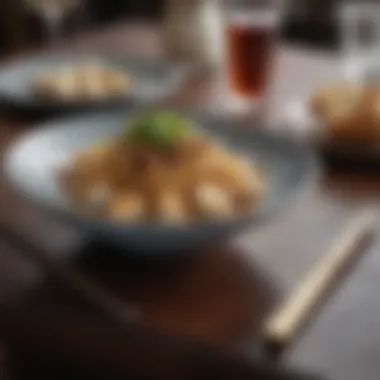

Consumer Preferences in Tableware
When examining consumer preferences in tableware, several factors emerge that influence choices:
- Sustainability: Many buyers now prioritize environmentally sustainable options. The reduction of single-use plastic, for instance, has prompted interest in reusable materials like glass. This shift is often reflected in purchasing decisions, as consumers actively seek brands that demonstrate commitment to the environment.
- Design and Aesthetics: The aesthetic appeal of tableware plays a significant role. Consumers appreciate stylish designs that reflect their personal taste and elevate their dining experience. Glass chopsticks, for example, offer both functionality and visual appeal, making them attractive to discerning customers.
- Health and Safety: As awareness of health concerns increases, particularly regarding food safety, glass chopsticks have gained favor due to their ease of cleaning and resistance to harmful chemicals, making them a preferable choice for many.
These preferences are reshaping the market landscape, leading to increased demand for high-quality, well-designed glass chopsticks that meet modern consumers' expectations.
Pricing Dynamics and Accessibility
Pricing dynamics in the glass chopstick market are influenced by several factors:
- Material Quality: Higher quality glass typically commands a premium price. Consumers are willing to pay more for chopsticks made from durable, well-crafted materials. This investment translates into a perception of superior quality and longevity.
- Retail Channels: The accessibility of glass chopsticks has expanded with the rise of online shopping platforms. E-commerce has allowed consumers to easily compare prices, search for specific designs, and find competitive offers. Traditional brick-and-mortar stores still play a role but are increasingly complemented by online options.
- Brand Positioning: Brands that position themselves as luxury or artisanal often adopt higher pricing strategies, which can influence consumer perceptions of value. There is a market segment that associates higher costs with better quality, which can drive sales in certain demographics.
- Global Trade Factors: Fluctuations in international trade can also affect pricing. Tariffs, shipping costs, and changes in supply chains due to global economic conditions may impact the availability and cost of glass chopsticks, further complicating pricing dynamics.
In summary, understanding the market trends and retail insights concerning glass chopsticks provides a deeper comprehension of consumer behaviors and preferences. This knowledge is crucial for manufacturers and retailers aiming to meet the demands of an evolving market.
Craftsmanship in Glass Chopstick Production
Craftsmanship plays a significant role in the production of glass chopsticks. It reflects a blend of tradition and modern skills, aiming to achieve both a functional and artistic piece. The process requires meticulous attention to detail, which is essential given the delicate nature of glass materials. In this section, we explore artisanal techniques, the skills involved, and the impact of craftsmanship on the overall quality of glass chopsticks.
Artisanal Techniques and Skills
Crafting glass chopsticks involves a variety of artisanal techniques that have been honed over time. One key method is the glass-blowing technique, where heated glass is shaped to create a hollow form. This technique allows artisans to produce chopsticks that are not only functional but also visually appealing. Each pair is unique, reflecting the individual style of the craftsman.
Another technique is hand-molding, which enables artisans to create specific designs and patterns. This can include intricate engravings or colored glass inlays. Artisans usually undergo years of training to master these techniques. They learn to balance precision with creativity, ensuring that each chopstick is both aesthetically pleasing and perfectly aligned.
"The mastery of glass craftsmanship speaks volumes about the value these utensils hold in various culinary traditions."
Additionally, the use of finishing techniques such as polishing and sanding helps enhance the tactile experience. Smooth finish enhances the grip, making them more enjoyable to use during meals.
Impact of Craftsmanship on Quality
The level of craftsmanship directly influences the overall quality of glass chopsticks. High-quality chopsticks exhibit clarity in glass, minimal imperfections, and enduring strength. Skilled craftsmen pay careful attention to the thickness of the chopstick; too thin can lead to breakage while too thick reduces comfort in use.
Quality control is also essential in this process. Each batch undergoes rigorous inspections to ensure consistency and reliability. Here are a few aspects where craftsmanship impacts quality:
- Durability: Well-crafted glass chopsticks are durable and resistant to thermal shock. They can handle temperature variations without cracking.
- Visual Appeal: Unique designs and colors reflect the artistic skill of the maker, enhancing the overall dining experience.
- Functionality: The balance and feel of the chopstick are crucial; they should provide a good grip and precise control while eating.
Consumer Education and Usage Tips
Understanding proper usage and care of glass chopsticks is pivotal. This section addresses essential aspects of consumer education, guiding users to maximize their dining experience and maintain their utensils in optimal conditions.
Proper Care and Maintenance
Glass chopsticks are distinct from traditional wooden or plastic options. To ensure longevity and performance, users should follow a few simple maintenance tips.
First, always wash your glass chopsticks by hand with warm, soapy water. While many glass utensils are dishwasher-safe, the high temperatures can lead to wear over time. Avoid using abrasive scrubbers, as they can scratch the surface.
Make sure to dry your chopsticks thoroughly before storing them. Any moisture left can promote the growth of bacteria, undermining their hygienic properties.
In terms of storage, choose a cool, dry place. Consider using a dedicated holder to prevent them from clinking against other utensils, which could lead to chips.
Benefits of proper care include:
- Extended lifespan of your chopsticks
- Enhanced appearance over time
- Maintaining hygienic standards, thus ensuring safe use
Tips for Beginners
For those new to using glass chopsticks, there are crucial tips for a smooth experience. Familiarize yourself with the basic grip. Hold the first chopstick stead, using your thumb, index, and middle fingers. The second chopstick should be maneuvered with your index and middle fingers while the other chopstick remains stationary. Practice is key.
Start with lighter foods. Foods like boiled vegetables or soft noodles are easier to manage as you learn. Avoid attempting to pick up slippery or very small items initially.
It can also be beneficial to watch videos or tutorials focused on using chopsticks. Seeing the motions can aid in understanding grip and movement. Joining a dining experience where chopsticks are used can provide practical learning and cultural insight.
Important tips for beginners:
- Practice holding before attempting to eat
- Use easier foods to gain confidence
- Learn through observation and practical experiences
"Education in the usage of utensils can greatly enhance the enjoyment of diverse cuisines, particularly for newcomers to chopstick etiquette."
In summary, understanding both care and usage of glass chopsticks elevates the dining experience. This ensures that users appreciate not just the functionality but also the cultural significance behind this unique utensil.
Environmental Considerations in Glass Production
The production of glass chopsticks raises essential environmental considerations that cannot be overlooked. With increasing awareness about sustainability, this section aims to explore the key elements involved in the glass production process, emphasizing the environmental benefits and the necessary considerations.
Recycling and Reusability Aspects
Glass is one of the most recyclable materials available today. Unlike plastic, which can degrade in quality after multiple recycling processes, glass can be infinitely recycled without loss of integrity. This characteristic greatly enhances its environmental value, especially when compared to disposable utensils.
When used in the context of chopsticks, the ability to recycle glass ensures that even when they are damaged or broken, the material does not contribute to landfill waste. Instead, broken glass can be repurposed for new products, reducing the need for raw materials. The process of recycling glass involves melting down the broken pieces and remolding them into new glass products, which requires significantly less energy compared to producing glass from sand, soda ash, and limestone. This not only conserves energy but helps in reducing greenhouse gas emissions, making glass an eco-friendly alternative.
- Reusability: Glass chopsticks are durable and can be cleaned easily. They can be used repeatedly, minimizing single-use waste.
- Sustainability: By choosing glass over plastic, consumers engage in sustainable dining practices, promoting a cleaner environment.
- Aesthetic Appeal: Glass chopsticks often feature unique designs that enhance the dining experience, encouraging their usage over single-use options.
Comparison with Plastic Alternatives
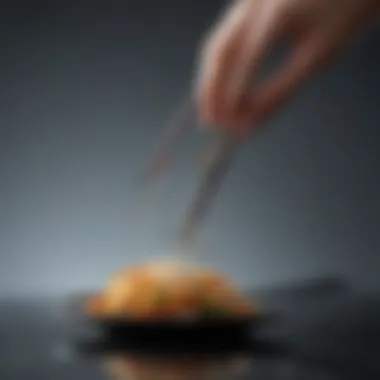

When comparing glass chopsticks to their plastic counterparts, the differences in environmental impact become evident. Plastic chopsticks are typically produced in large quantities and are often designed for single use. After being discarded, many of these plastic utensils are not biodegradable, contributing significantly to global plastic pollution.
In contrast, glass chopsticks offer a sustainable solution. They pose no threat to wildlife when discarded, as they are not an environmental hazard like plastic. Furthermore, glass manufacturing processes can be optimized to reduce emissions, aligning with current environmental standards and regulations.
Here are some factors to consider when comparing the two:
- Longevity: Glass chopsticks can last a lifetime if handled correctly, whereas plastic chopsticks might break or wear out quickly.
- Taste Preservation: Glass does not leach chemicals into food as some plastics might, ensuring the flavor of the food remains intact.
- Consumer Mindset: There is a growing trend among consumers towards sustainable choices, making glass utensils a preferred option for eco-conscious diners.
"Choosing glass over plastic for dining utensils is not just a personal choice; it's a statement of environmental responsibility."
In summary, the environmental considerations in glass production are vital in understanding the impact of glass chopsticks. Recyclability and reusability enhance their sustainability, while their benefits over plastic alternatives present a compelling case for making the switch. This conscious choice contributes to a healthier planet and promotes a dining culture that respects environmental boundaries.
Global Perspectives on Utensils
Understanding global perspectives on utensils is vital when exploring glass chopsticks. It allows us to appreciate not just their function, but their cultural implications across diverse dining practices. In a world ever more connected, the merging of culinary traditions reflects broader societal shifts. Emphasizing this perspective enhances our knowledge of glass chopsticks' place in modern dining.
Chopsticks in Western Dining
While chopsticks have strong roots in Asian cultures, their adoption is rising in Western dining settings. In many restaurants today, chefs often serve Asian cuisine with glass chopsticks. This choice speaks volumes about both cultural appreciation and culinary integration.
There are a few reasons why glass chopsticks appeal to Western diners:
- Visual Appeal: Glass chopsticks come in various colors and designs, often displayed attractively on tables.
- Familiarity: As Asian foods grow in popularity, diners seek authentic experiences, which glass chopsticks provide.
- Sustainability: With growing awareness surrounding sustainability, glass is seen as a more eco-friendly option compared to plastic.
This trend exemplifies a shift in diners' openness to new utensils. Glass chopsticks are no longer restricted to Asian restaurants but find their way into a variety of dining experiences.
Crossover of Techniques and Cultures
The crossover of techniques reflects a rich dialogue between cultures. It helps us recognize culinary utensils' role beyond mere function. Techniques used to handle chopsticks can vary greatly based on cultural context. For example, some diners in the West may initially struggle with chopsticks, leading to adaptations of their use.
This adaptation showcases:
- Hybrid Dining Practices: Chefs are now creating fusion dishes that incorporate glass chopsticks, merging Western methods with Eastern culinary flair.
- Educational Initiatives: Many restaurants now offer lessons or guidance on using chopsticks, breaking down barriers between cultures.
- Cultural Identity and Expression: Using glass chopsticks in Western settings highlights growing multiculturalism.
Overall, the growing acceptance and integration of glass chopsticks in Western dining brings different culinary traditions together, fostering a deeper understanding through shared practices.
"The way we eat shapes our interactions and connections. Utensils like chopsticks are more than tools—they are cultural symbols."
This observance ensures that as we embrace diverse utensils, we also acknowledge their historical significance and the continued evolution of dining practices.
Future Outlook for Glass Chopsticks
The future outlook for glass chopsticks reflects a growing interest in unique dining experiences and the emphasis on sustainability. As culinary practices evolve, the tools we use in our dining rituals, such as glass chopsticks, must also adapt. With the resurgence of traditional dining cultures intertwined with modern aesthetics, glass chopsticks serve as a bridge between these realms. Understanding the future of glass chopsticks requires us to consider various dynamics.
First, there is the matter of consumer preferences. Today's diners are increasingly conscious of environmental impacts. They seek alternatives to plastic utensils, leading to a rise in demand for reusable, sustainable options. Glass chopsticks not only offer durability but also enhance the presentation of food, aligning with the aesthetics sought by food enthusiasts.
Second, we should recognize the influence of technology. Innovations in glass production techniques are making these utensils more accessible. Advanced manufacturing methods allow for intricate designs while maintaining strength and functionality, appealing to both chefs and everyday users.
"The integration of style and sustainability will shape the future of dining accessories, making glass chopsticks a likely centerpiece."
Emerging Trends in Dining Culture
Recent shifts in dining culture indicate a blend of traditional practices with modern sensibilities. As global cuisines intermingle, there is a noticeable trend towards the appreciation of cultural tools, such as chopsticks, beyond their geographical origins.
- Fusion Cuisines: Chefs experiment with traditionally Asian dishes, promoting the use of chopsticks, including glass variants, which adds a unique flair.
- Experiential Dining: Restaurants focus on creating memorable experiences, where the aesthetic role of glass chopsticks enhances the visual aspect of dishes served.
Dining also extends into purely aesthetic realms, where tools become part of the dining decor. Versatile Chinese or Japanese cuisine often embraces these tools. Their lightweight nature also makes them portable, catering to the growing trend of picnics and outdoor dining, where convenience and presentation matter.
Potential Innovations to Watch
As the glass chopstick market grows, several potential innovations are emerging that can reshape their presence in the dining world.
- Smart Technology Integration: Future productions may involve smart materials that can change color based on the temperature of the food, enhancing the sensory experience.
- Customization Options: Companies may offer personalization through engraving or color choices, appealing to consumers seeking unique dining tools for special occasions.
- Enhanced Durability: Ongoing research into glass materials may lead to the development of tougher, more resilient varieties that resist breakage while retaining elegance.
In essence, the future of glass chopsticks is promising. It encompasses a synergistic relationship with evolving dining cultures, sustainability practices, and technological advancements that appeal to a wider audience.
Ending and Reflections
The exploration of glass chopsticks reveals a convergence of craftsmanship, culinary culture, and modern dining philosophy. In this article, we have examined various facets, including their material properties, design features, and cultural significance. Understanding the complexities of these utensils leads to greater appreciation of their role in dining contexts. Glass chopsticks, with their distinctive aesthetic and functional attributes, represent an evolution in utensil design that aligns with contemporary values.
The relevance of this topic extends beyond mere functionality. Glass chopsticks can be seen as a bridge between tradition and modernity. They come with a set of benefits, including hygienic properties and aesthetic appeal. Their growing popularity also is accompanied by considerations like sustainability and health, aspects that are essential in today’s conscious consumer market.
Integrating glass chopsticks into modern dining can elevate the culinary experience. Their unique characteristics allow for engaging presentations that complement various cuisines. As society becomes more intertwined with global culinary practices, understanding such tools becomes crucial.
"The use of elegant utensils can transform the dining experience, making it memorable and special."
Summarizing the Key Points
Throughout this article, several key points have been outlined:
- Definition and Overview: Glass chopsticks are more than just utensils; they are cultural artifacts that enhance dining experiences.
- Material Composition: Exploring the types of glass used highlights both the durability and aesthetic characteristics of these tools.
- Design Features: The aesthetic and functional aspects add layers of complexity to the glass chopsticks.
- Culinary Applications: Glass chopsticks facilitate a variety of cooking techniques and pair well with diverse cuisine types.
- Health Considerations: Their hygienic properties and durability make them a promising choice over traditional options.
- Cultural Significance: There is a fascinating interplay between glass chopsticks and global dining traditions, shedding light on evolving trends.
- Market Dynamics: Consumer preferences are shaping the availability and pricing of these unique utensils.
- Craftsmanship: Artisanal techniques impact the quality and desirability of glass chopsticks in the market.
- Environmental Considerations: The sustainability aspect of production places glass chopsticks in a favorable light amid growing concerns about plastic use.
- Future Trends: Continuing innovations may lead to novel designs that align with modern dining needs.
Each of these themes contributes to the broader understanding of glass chopsticks in contemporary society.
The Role of Glass Chopsticks in Modern Dining
Glass chopsticks are gaining traction in various dining settings, redefining how meals are presented and enjoyed. Their role transcends functionality; they serve as conversation starters and artistic expressions on a table. The way food is presented can significantly enhance its perception and enjoyment.
In modern dining scenarios, these utensils reflect trends toward minimalism and elegance. Their transparent nature lends a refined quality to the dining experience. Additionally, they resonate with sustainable practices, appealing to an audience that values environmental conscientiousness.
- The aesthetic appeal of glass chopsticks can elevate casual meals, transforming them into sophisticated dining experiences.
- Their hygienic properties make them a safe alternative for both home and professional kitchens.
- As cultures blend through culinary exploration, glass chopsticks serve as a common ground, promoting shared dining experiences across different food traditions.
Adopting glass chopsticks signifies a shift in dining preferences, emphasizing a blend of functionality, elegance, and sustainability. As they become more widely embraced, glass chopsticks may redefine what dining experiences can mean in a global context.












